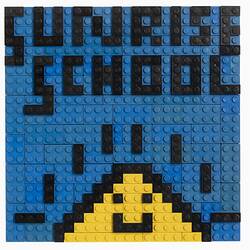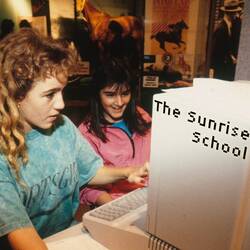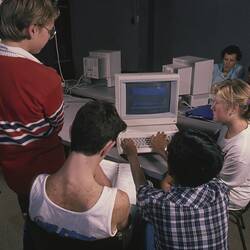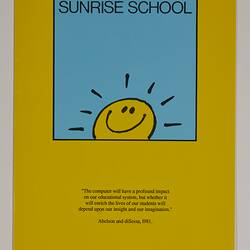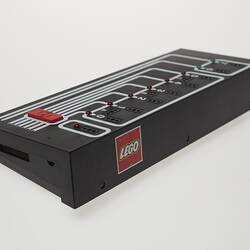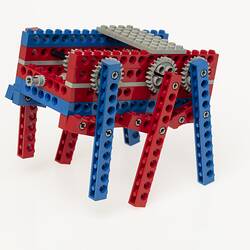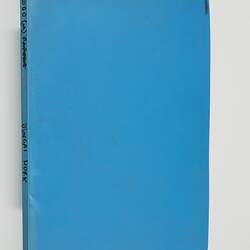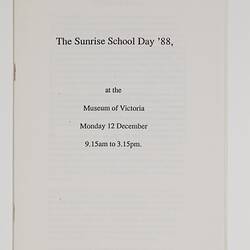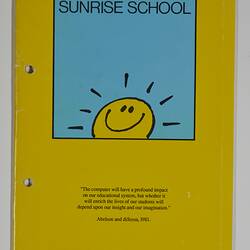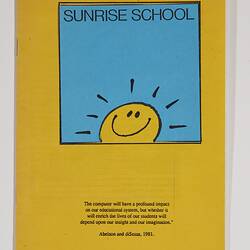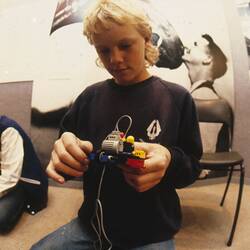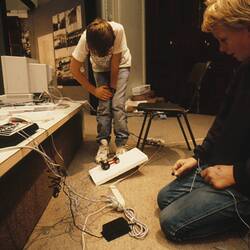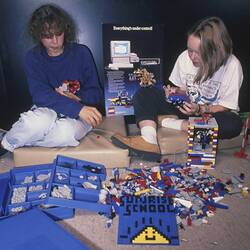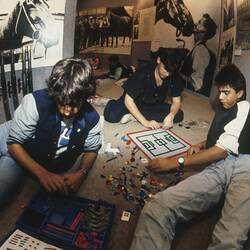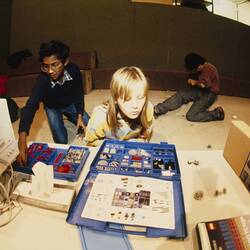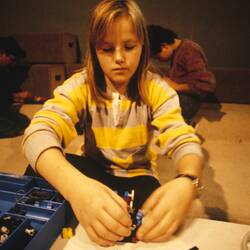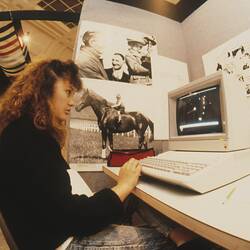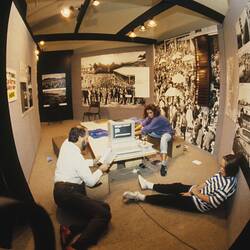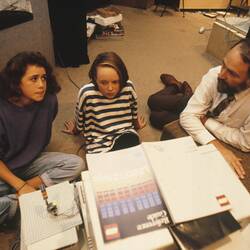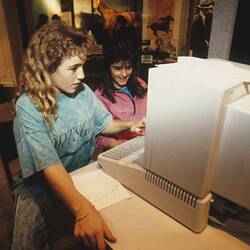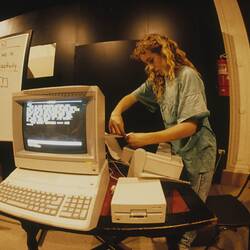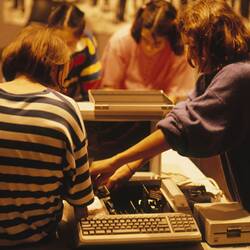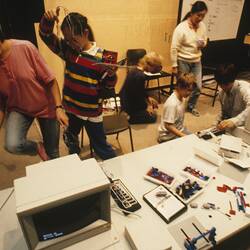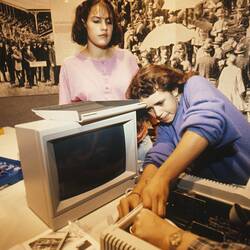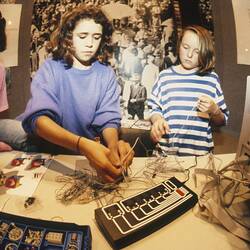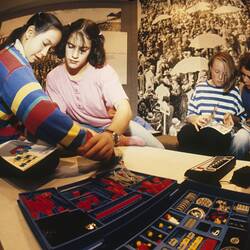The Sunrise School was a research and development project initiated by the Australian Council for Educational Research (ACER) and developed in collaboration with the Museum of Victoria (now Museums Victoria) that operated between 1988 and 1989.
Originally referred to as the School of the Future, the Sunrise School aimed to provide a futuristic educational environment in which to explore and document the ways in which computers and other digital technologies might lead to changes to learning and teaching.
The Sunrise School classroom was purposefully located inside a museum in a bid to disrupt the conventional culture of school-based learning which it was thought might act to restrict the type of student and teacher autonomy necessary to engage in exploratory practice and because there was a suspicion that the radical change in technology might also change the nature of learning environments, and schools. In the North Rotunda of the museum, nestled amongst a collection documenting the social and historical context of legendary racehorse Phar Lap, were the classroom's ten Apple IIE microcomputers loaded with Logo (an early programming language designed to be used by children). There was also robotics equipment (including programmable turtles and Lego) and a range of other peripherals. Rather than a complete school, the Sunrise School involved a select group of students and their teachers accessing the classroom on a part-time basis.
In two years of operation, the Sunrise School provided access to a range of groups, including current teachers, and a group of pre-service teachers enrolled in primary mathematics teaching at the Footscray Institute of Technology. The core participants in the project were teachers and students from Princes Hill Secondary College. For two afternoons per week through the 1988 and 1989 school years, a class of twenty-four middle secondary students (Year 8/9) and their mathematics and science teachers attended the Sunrise School classroom. While these students had used computers at their own school, in the Sunrise School classroom they worked with the Logo programming language in developing screen objects and controlling the robots. Their teachers worked to engage them in projects that depended on the use of computer technology. Primarily, this allowed for student-chosen projects and moving away from a teacher-centred approach towards a learner-centred one. Teachers would act as facilitators, supporting students as they undertook meaningful, self-directed projects that made use of the school's technological tools and the museum's cultural inputs to construct a digital or tangible output, and through this process construct a little new personal knowledge. Often the students worked in the geometric microworlds of the Logo environment which provided important opportunities for learning. This approach, grounded in constructionism (an extension of constructivist learning theory), emphasised student autonomy, self-discovery, creativity, and iterative problem-solving, and exposed how digital technologies could be used most effectively to support this type of learning.
As an action research project, the activities undertaken at the school were variously monitored and documented in a range of formats; as were the personal reflections of the teachers, students and researchers. The Sunrise School also opened itself up to external visitors, and many administrators, teachers and researchers came to observe first-hand how computers might be used as a tool to engage students in more empowering and effective forms of learning.
Although the Sunrise School was not without its issues, and consequently closed before the end of its planned three-year cycle, this audacious demonstration project had a significant impact on educational computing in Australia and internationally.
It was informed by, and informed, a number of projects internationally. The Sunrise School stimulated important discussion in the Australian education sector around the role that computers could play in education reform, and it attracted the world's leading educational computing experts to come to Australia and contribute to that discussion.
Following the Sunrise School, three Sunrise Centres in schools were developed; the Methodist Ladies College (MLC Melbourne) Sunrise Centre in Victoria, the Queensland Sunrise Centre at Coombabah State School and the Batlow Sunrise Centre in NSW. There was also a major project at RMIT University. These centres extended the groundbreaking work of the Sunrise School into both public and private school settings, generated some important research outcomes, and informed developments in Australian educational computing policy. Notably, the MLC Sunrise centre led to the world's first laptop classes in 1990, where the distinction was not just that every student had a laptop, but that the classroom context in which they would be using them was free to be reformed by their teachers to better facilitate new types of learning.
References
Context: Educational Computing in Australia and Victoria
Johnstone, B. (2003). Never mind the laptops: Kids, computers and the transformation of learning. Lincoln, Nebraska: iUniverse.
Jones, A., McDougall, A. & Murnane, J. (2004). What did we think we were doing? In History of computing in education (pp. 63-72). Springer US.
McDougall, A., & McCrae, B. (2000). From CEGV 1979 to ACEC 2000: Australian computers in education conferences come of age. Australian Educational Computing, 15(1), 3-6.
Tatnall, A. (2014). Schools, computers and curriculum in Victoria in the 1970s and 1980s. In A. Tatnall & B. Davey (Eds) Reflections on the History of Computers in Education. IFIP AICT V. 424, 246-265.
Walker, R. (1991). The development of educational computing policy in the Victorian school system, 1976-1985. Australian Journal of Education, 353, 219-313.
The Sunrise School and Sunrise Practice
Loader, D. (1993) 'The Audacity of Sunrise', in Grasso, I., & Fallshaw, M. (Eds.). Reflections of a learning community: Views on the Introduction of Laptops at MLC. Melbourne: MLC.
Nevile, L. (1988a) The Sunrise School - A School of the Future Project, ACER (paper presented to the Australian Computer Society, 19 May 1988).
Nevile, L. (1988b) The Sunrise School in the Museum: An interim report of activities in 1988, draft - unpublished (held in the print archives of the Melbourne Museum).
Nevile, L. (1990) Sunrise. Unpublished Report: ACER.
Ideas Informing the Sunrise School
Brand, S. (1987) The Media Lab: Inventing the Future at MIT. New York: Viking Penguin.
Papert, S. (1980) Mindstorms - Children, Computers and Powerful Ideas. New York: Basic Books Inc.
Resnick, M. (2017) Lifelong kindergarten: cultivating creativity through projects, passion, peers, and play. Boston: MIT Press.
ACER and Sunrise
ACER (1990) Annual Report 1989-90, Australian Council for Educational Research.
The Museum of Victoria and Sunrise
Hancock, J.A., & Thompson, J. (1986) Museum development study: future directions for the development of the Museum of Victoria. Summary report. Melbourne: Museum Development Study Steering Committee.
Rasmussen, C. (2001) A museum for the people: a history of Museum Victoria and its predecessors, 1854-2000. Carlton: Scribe Publications.
Princes Hill Secondary College and Sunrise
Vlahogiannis, N. (1989). Prinny Hill: the state schools of Princes Hill, 1889-1989. Melbourne: The Princes Hill Schools.
Sunrise Centres - MLC, Queensland, Batlow
Braggert, E.J. (1993) Laptop Use at Batlow Technology School. Charles Sturt University.
Finger, G.D. (1995). Evaluating the integration of learning technology in Queensland state schools: A case study of the Queensland Sunrise Centre. Australian Council for Educational Research.
Johnstone, B. (2003) Never Mind the Laptops: Kids, Computers, and the Transformation of Learning, iUniverse, Lincoln.
Rowe, H.A., Brown, I., & Lesman, I. (1992) Learning with personal computers: issues, observations and perspectives. Australian Council for Educational Research.
Ryan, M., Betts, J., Grimmett, G., Hallett, K., & Mitchell, D. (1991) The Queensland Sunrise Centre: a report of the first year. Australian Council for Educational Research.
More Information
-
Keywords
-
Authors
-
Article types

